
|
The history of cinema sound spans over approx 100yrs and is a subject so vast that it is not possible for one person to be an expert in every facet. Some subjects are abridged to focus on essential points and we welcome views and or corrections. Many myths and memes are challenged within this industry and hopefully critical points will be accepted in good humour. 'Memes' are ideas and practices which spread within a culture that are rarely questioned. The aim is to evoke thought on each subject so as to aspire all involved to bring sound and vision into equal partnership. |
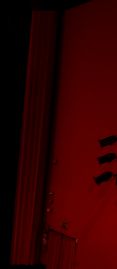
|
Cinema sound overview

What you wanted to know about 5.1 but were too afraid to ask
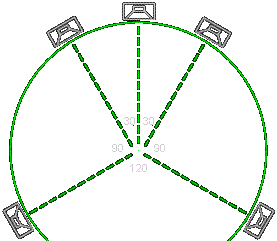
5.1 refers to the protocol of speaker placement for the separate sound tracks.
(left - center - right) (left-rear - right-rear) and (.1 for sub-bass)
5.1 does not refer to sound quality or realism. The majority of home cinema sound systems consist of 5 small loud-speakers, which is all that is necessary to hear the periodic novelty of sound from the 5 positions. The (.1) sub-bass box is a low cost solution for bass not obtainable from the 5 small speakers.
The history of surround sound formats for cinemas including sound alignment procedures are a mess to say the least. Mono has always been the standard and everything else became add-ons. There are large inconsistencies between films. Many B grade films are recorded in mono, with post-production pseudo stereo effect for left and right; rears and sub-woofer periodically turned on and off. Then there are the disjointed sub-bass effects often consisting of sequenced bursts of filtered pink noise to generate a mindless emotive reaction, similar to the TV sitcom use of clap-trap.

A Full Fidelity Stereo gives greater realism than 5 small low fidelity speakers.
Imagine if you will, given the choice between the largest screen with the smallest low fidelity 5.1 sound system, or the smallest screen with the most magnificent stereo system money could buy.
For well produced films with excellent sound tracks, a large stereo full-fidelity music system will sound more realistic and enjoyable than five small low fidelity home-cinema speakers. However 5 large full-fidelity speakers can transform the home-cinema experience well beyond what is provided by the present sound systems in large cinemas.
Home Cinema Marketing Sigmund Freud and Carl Jung would have loved home cinema; but if alive today they would have a great deal to say about the marketing. In the era before Television, home entertainment marketing often showed a family sitting around a radiogram, in a softly furnished fire-lit room. By contrast, modern marketing shows isolated people in a bright unfurnished reverberant room, reflecting a superficial lifestyle with little interest in music, except with ipods.

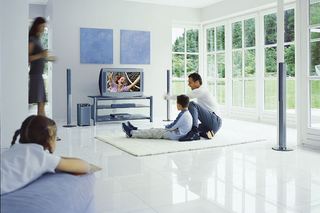
The modern home architecture of white un-furnished reverberant rooms has more in common with mausoleums that symbolise perpetuity of the dead, rather than the enjoyment of living in the present.
Excessive bright reverberant rooms are the worst environments for home cinema or music to be experienced. The majority of sound heard in modern homes from people talking, general background clutter or from sound systems, is annoying continuous reverberation and echo reflected from walls floor and ceiling. Articulation for dialogue is diffused, making it difficult to understand the words being spoken. In these hard minimal furnished rooms the surround speakers of home cinema systems make the reverberant problem worse.
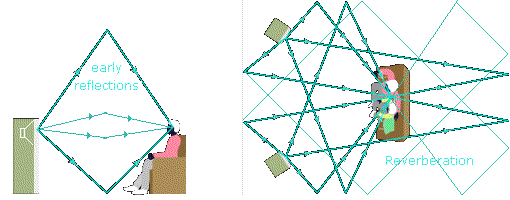
Films with beautiful sound tracks and intellectual depth, are sound quality and dialogue dependent, and have no value when experienced in excessive bright reverberant environments. It's easy to understand that the majority of home cinema marketing is aimed at the lowest intellectual level. Sports, football, motor racing, understandably have no demand on sound fidelity or dialogue articulation. There is no point to discuss information on cinema sound when applied to applications that have no demand for fidelity or experienced in excessive reverberant environments.
For Home Cinema to have its place, it will have to integrate (not dominate) within homes that are comfortable and softly furnished, where family, laughter and music are our primary experience.
Approx 1 in 30 films are magnificently produced with full fidelity and continuous integrated surround sound. Over many decades this small percentage of excellently produced films has evolved into a large number. This percentage of intelligently crafted films generate a passionate following for those of us who enjoy the cinema experience in an acoustic absorbent environment with an excellent sound system and high quality vision.
Cinema of the Golden era
Going to the movies is a magical experience the whole of humanity shares and belongs to us all. The history of movies began in the 1890s and another 20 years would pass before the technology for sound was invented. Sound first arrived in cinemas in the late 1920s. This period till the late 1940s was described as cinemas Golden era.

Sound from the early optical sound track on the edge the film stock struggled to reach 6kHz. Increasing the physical size of the optical track gave a larger signal but with less hi-frequencies. A smaller optical track gave a higher frequency response but with less signal level and greater noise. Noise hiss was also generated from the film reader and early valve pre-amplifiers. Putting a hi-frequency filter at the output of the pre-amplifier reduced the noise hiss, but further reduced hi-frequencies. The simplest solution developed in the 1930's was to boost the hi-frequencies when recording, and allow the play back noise reduction filter to achieve a close to flat response as possible to provide some consistency between the recording on film and playback in the cinema.

Because almost every cinema rushed to install sound as soon as it arrived, it was difficult to take advantage of technological improvements in sound systems designs that followed shortly after. Only a limited number of mixing studios and cinemas could afford to keep continuously upgrading to the latest technology. The majority of cinemas had poor sound systems in comparison to later developments. High and low frequency response was almost non-existent.
Academy characteristic In 1938 a study of the 'worst case' cinemas in the US showed an average energy (frequency) response of (-7 dB at 40 Hz) (flat 100 Hz - 1.6 kHz) (-10 dB at 5 kHz) (-18 dB at 8 kHz). This is said to be the Academy Curve.
Mixing studios could then apply equalization to simulate the poor response of the 'worst case' cinemas, to be able to craft and evaluate the soundtrack as it would be heard by the majority of audience. This practice became the foundation (trend) for how soundtracks were and are prepared. Many variations of the Academy curve followed and later became re-named the X-curve.
The practice of modifying sound performance for the mass end of the cinema exhibition market has always been hotly debated, because it is based on assumptions and compromise. This practice also institutionalised lower performing sound systems as being the benchmark for the characteristic 'cinema sound' and later represented a blockade restricting hi-fidelity sound from being the adopted goal when technology allowed. This can be argued as being an economic rationalist solution, not a technical or scientific solution.
The un-foreseen and un-fortunate outcome from this compromised approach made it difficult to implement improvements beyond what was initially incorporated, and has basically remained for 35mm film until the 1970s. Even with these limitations, cinema sound from optical format was better by comparison to home record players and radios, until the early 1960s when superior hi-fi stereos became available.
European film industry It has been argued that pre WW2 European film technology was superior to the US. German cinema technology was said to have been favouring a flat response which came close to achieving 8kHz. The expectation may have been that cinemas would aspire to full fidelity sound by installing the most advanced technology available, with no compromise for poor quality sound systems or acoustics.
The demise of the European film industry during WW2 is said to have resulted in the US dominating the world with its approach of a compromised alignment for the majority of cinemas which had poor quality sound systems and acoustics.
Early speaker systems
Early speaker systems achieved the best performance with the technology available, and most research on horn technology at that time has been un-surpassed. The aim was to achieve the highest efficiency and voice articulation which horns are ideally and uniquely suited to. Also valve amps of that time were approx 30 to 60 Watts. This resulted in the efficiency and size of the horn speaker systems being taken to the technological limit. The narrow bandwidth from the mono optical sound track (100Hz - 4kHz) set the precedent for the speaker systems only needing to be 2 way passive without tweeters. The 15in speakers and horn were and still are crossed over at approx 700Hz.

Most cinema speaker systems have remained principally the same as when first applied. Two 15in speakers for the low frequencies, a compression driver with horn for hi-frequencies. Crossed over at approx 700Hz. Altec Lansing, Western Electric and other well known companies aspired to make the highest quality sound systems with the resources available.
But many early cinemas could not afford the best quality systems. The hi-frequency compression driver with horn are approx +20dB more efficient than the 15in speakers. Sometimes it was difficult to correctly equalize both components to sound flat, because sound measurement equipment was rare and expensive. Cheap crossovers consisted of a simple capacitor and resistor only.

Many sound systems had to be aligned by ear. Because of the limited power of early valve amps, the horn driver was sometimes kept close to full efficiency with little attenuation. This was done to obtain as much sound level as possible, especially for large cinemas. Cinema screen and air attenuation, helped reduce the higher efficiency of the horn, bringing it back to a flatter response.
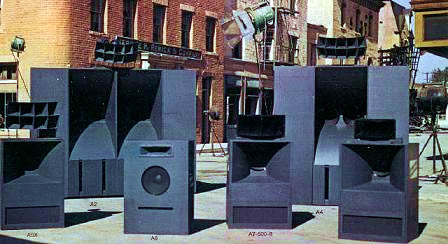
Cinema sound is recognised by the unique acoustical character (of the projected voice range) created by the horn systems used in all commercial cinemas throughout the world. Regardless of their limitations which will be discussed further on this page, large cinema horns are magnitudes greater in efficiency than domestic speaker systems.
Cinema horns have an acoustical directivity that projects the sound image forward into the audience, giving a feeling of dimension to the sound. Horns also increase the articulation of dialogue when correctly applied. The characteristic sound of the horn gives cinema its unique sound quality. It is not possible for small domestic cone speakers in home-cinema systems to replicate the experience of large horn speakers in commercial cinemas.
mass - average - performance - acceptance
The marketing philosophies of capitalist economic principles favour technology being reduced to achieve mass average acceptance, humorously described as McDonaldizing. Audio replication (fidelity) has been uniquely compromised, held back, limited and modified from delivering the highest performance possible throughout its history.
Un-resolvable mess. The principles behind the Academy and later X-curve were not intended to utalise the best performance technology is capable of, for high quality sound reproduction in acoustically controlled venues. Over many generations starting from the original Academy EQ and later recording and playback EQs for different optical and magnetic formats, noise filters, noise reduction systems, speaker alignment and cinema acoustics all became entangled into an un-resolvable mess.
These problems are also seen with pop music which is extensively EQ modified, dynamically compressed and level boosted. This is done to achieve the maximum effect possible on the limited bandwidth of radio TV and MP3, mostly heard through small low fidelity speakers (ghetto blasters etc) in excessive reverberant environments.
It is often stated that a percentage of the population has no interest in how 'sound sounds'. Therefore it can be argued "Why waste effort in modifying sound recording and reproduction for those who are not interested ?". Many audio enthusiasts state that sound recording and reproduction should only be focused on achieving the highest fidelity possible for an appreciative audience, regardless of how small a percentage this is.
The next chapter describes a brief period of cinema history where the highest technical achievements without compromise to performance or cost were created, but was to fail when confronted by television, economic rationalism and superficial consumerism that followed.
Links
Cinema Associations
www.smpte.org Society of Motion Picture and Television Engineers
www.amps.net Association of Motion Picture Sound
cinematographer.org.au/ Australian Cinematographers Society
soc.org Society of camera operators (many links)
www.lucasfilm.com
www.filmsound.org
www.movieposter.com
www.soundtrack.net Recording for film
www.filmsite.org
Cinerama and 70mm
wikipedia.org/Cinerama
www.cineramaadventure.com Essential reading
www.cineramaadventure.com Videos of Cinerama experience.
www.widescreenmuseum.com Widescreen Museum
www.in70mm.com 70mm and Cinerama
wikipedia.org 2001 A Space Odyssey
wikipedia/Widescreen
www.fromscripttodvd.com List of 70mm films
www.imax.com
Cinema Sound Education & History
www.victorian-cinema.net Victorian cinema
www.audioheritage.org Audio Heritage
wikipedia.org/Sound_film Sound film
filmsound.org/loudspeakers 100yrs of Cinema Loudspeakers
www.curzon.org.uk Curzon Community Cinema & History
howstuffworks.com Movie Distribution
www.mediasalles.it Cinema Research Library
www.madcornishprojectionist.co.uk Mad Cornish Projectionist
www.fromscripttodvd.com links links and more links
Sound System Formats
wikipedia.org Surround sound
howstuffworks.com/movie-sound Movie-sound 1-6
howstuffworks.com movie-screen
www.soundonsound.com Surround Sound Explained
www.mkpe.com Multi channel Film
Cinema Sound Suppliers
professional.dolby.com/ Pro Audio Engineering
www.dolby.com
www.thx.com
www.dts.com
www.jblpro.com JBL cinema sound
www.panalogic.com.au
www.hps4000.com
www.sounddogs.com Sound effects library
www.christiedigital.co.uk
www.kodak.com Kodak Digital Cinema An Overview
www.kinoton.com
www.film-tech.com Projectionists forum as well
www.dcinematoday.com Digital Cinema today


